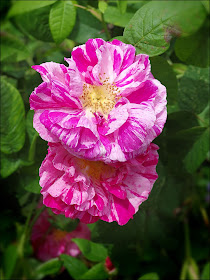Hop Hornbeam - ostrya carpinifolia
The Hop Hornbeam grows on the southern edge of the garden in amongst a varied selection of other trees. It makes it rather difficult to photograph, or indeed appreciate, the whole of it at a glance. It's as if the learned gardeners here have made the mistake that everyone else makes when planting trees - that of not realising just how big they're going to get!
Not that it's a tree to sink into anonymity amongst its fellows. It leans out over the path, dangling its branches in the faces of passers-by and demanding attention! And it gets that attention too, judging by the number of people who make their way over to read the little sign attached to he trunk.
The sign will tell them that it's origins are in Southern Europe and Turkey. The English name, Hop Hornbeam, refers to the hop-like clusters which it produces in summer, but seems suggest that it's a Hornbeam. In fact the Ostryas, although in the Birch family along with the Hornbeams, are a distinct group, though the carpinifolia part of the name means "with leaves like a Hornbeam".
Either way it makes it an easy tree to identify and remember the name of - as long as you know what Hornbeams and Hops look like. As you can see it also bears long catkins.
The trunk has many bumps and hollows as well as intricate though rather scruffy bark which is full of character. The timber is very hard and was traditionally used for making the old-fashioned wooden carpentry planes. It was too difficult to work to be of much use for anything else.
Rose - rosa
You sometimes overhear rose-enthusiasts muttering that they don't think much to the roses here and that some of them are no more than the wild roses that you find growing in the hedgerows.
They are rather missing the point: this is not a show-garden but a teaching resource and the roses here were laid out according to the work of Charles Hurst who spent a the first quarter of the twentieth century unravelling the hybridisation which had resulted in our wide array of modern roses.
Luckily, those of us less obsessed than Mr Hurst, can still enjoy some wonderful blooms.
Now, as long as I don't forget to show you the July photos from the garden, we shall have caught up!
Take care.













Ah...beautiful.
ReplyDeleteI know first hand about planting trees and not taking into account how big they will get. We have a Sugar Maple we planted about fifteen years ago, and what was a skinny sapling then is now a tree whose branches are touching the house. Pruning time I think!
ReplyDeleteA neighbor planted a sago palm where driveway met sidewalk. Time told the truth.
ReplyDeleteLovely roses.
More wonderful photos - I had not heard of the Hop Hornbeam - a lovley tree.
ReplyDeleteHi John - love the hop hornbeam ... glad it is featured. I've become so much more 'aware' of why things are done ... and now never complain about the layout of gardens etc - there's always a reason, and so often worth finding out. Good for Mr Hurst ... a real botanical explanation of life before hybrids etc ...
ReplyDeleteTrees do get rather large ... I know my brother planted a red horse-chestnut where some other trees will need replacing in due course ... it was near the gate and the driveway ... I mentioned it'll get rather large - he just said (quite rightly) it'll be a problem for someone else ... and it is taking its time to grow. But at least he can see it - it was a gift from me! Cheers Hilary
Such an interesting tree. It would never be able to grow here.
ReplyDeleteWe owe much to Hurst for his work.
Time is all relative, I believe, so go ahead and jump June photos into July! I appreciate them now! Roses that had a scent are far lost with hybrids, and that's a shame. But my favorite is that yellow fellow with all the frilly petals.
ReplyDeleteAh June was quite beautiful there. That tree is grand, and the flowers lovely.
ReplyDeleteI so love that tree! Wouldn't that be perfect for kids to play under, or to sit and read...or dream. And those roses are beautiful....
ReplyDeleteWhat a beautiful tree!
ReplyDeleteThe old roses are my favorite and I especially like the pink and purple colors together.
ReplyDeleteWe have a type of hornbeam tree on our place. The wood is very hard and another name for it is ironwood. However, it is a smaller tree.
What a gorgeous looking tree.
ReplyDeleteInteresting looking tree!
ReplyDeleteI really like that pink variegated rose. The prickly wild rose (rosa acicularis) is the provincial flower of Alberta.
That is a stunning tree and the roses are beautiful especially the ripple effect one. We planted a tulip tree about fifteen years ago and it is now huge:)
ReplyDeleteI love your tree a lot! It's a shame you can't get it all in one photo but it's still charming. The flowers are so fresh and pretty, especially on my winter day!
ReplyDeleteThat's one big tree!
ReplyDelete